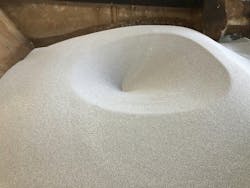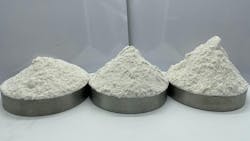Bulk solids flowability: Avoiding storage failures
Key Highlights
- Bulk solid flow failures often occur due to stable arches or ratholes formed within storage vessels.
- Flow properties are best predicted through shear and wall-friction testing, which measure material resistance under stress conditions.
- Factors such as time at rest, temperature, and humidity can significantly impact flowability.

Every system has points of failure where, if one thing does not happen, then nothing will happen. Bulk solid materials introduce this path to failure for many systems, and the failures are numerous.
Why bulk solid storage systems are prone to flow failures
Our interactions with bulk materials are comprised of transportation, modification, and use, and between these interactions are periods of storage. We entrust this storage to a range of vessels, from small portable containers to large silos. However, after placing material in a container, coaxing the material back out of storage in a controlled manner can often be a challenge.
Many materials are prone to no-flow scenarios, in which no material discharges from the storage vessel despite the vessel outlet being open. This is often due to a stable arch that obstructs the outlet or the formation of a stable rathole in which the outlet is not obstructed but material remains stagnant around the perimeter of the vessel (Figure 1). Both problems are due to the flow properties of the material in storage.
Measuring flow properties with shear and wall-friction testing
The flow properties of a bulk solid material are those values derived from testing the material to determine its resistance to movement. These properties can be measured using a device such as a Jenike Shear Tester. Two key tests are measurement of the material’s cohesive properties by shear testing and measurement of the material’s friction with contact surfaces by wall-friction testing (Figure 2).
The testing serves as a lens for predicting how a material will behave during discharge from a storage vessel. The testing also provides guidance for designing a new storage vessel that considers the properties of the material to be handled. But it is important to note that the same bulk solid material will behave differently depending on the conditions the material has been exposed to.
Limits of angle of repose as a flowability indicator
One crude metric commonly used when considering a material’s flowability is the material’s angle of repose, which is the slope formed by a pile of the material. It is simple to pour material into a heap and measure the angle of the resulting pile. Materials with more interparticle friction and greater attractive interparticle forces often exhibit a steeper angle, which would seem to indicate a more poorly flowing material.
However, because flowability is not a fixed constant for bulk solids, the same exact material can produce piles with a range of slopes depending on how the pile is formed (Figure 3). This demonstrates that angle of repose is not a single constant value and can vary.
Flowability depends on stress conditions
Understanding a material’s flowability requires measuring how the material responds to specific conditions and stress levels. The stress levels should be meaningful and should correspond to the conditions encountered during storage. For storage applications, flowability depends on placing the material under stress, which is why values such as angle of repose — where the material has not been subjected to stress — should be approached with caution.
For comparison, consider a person taking a cardiac stress test. The test requires active participation from the subject and measures the result of intense physical activity. The test information cannot be gleaned if the subject is sitting peacefully, only by capturing the subject’s vitals while they undergo prescribed physical activity.
How consolidation load affects material flow
The flowability of a bulk solid material is often impacted foremost by a load acting on the material. Problems often arise due to the weight of the material on itself imparting cohesion or sticking to contact surfaces. This means that the size of a storage vessel and its fill level can impact the ability to achieve discharge.
A bulk solid’s flowability is a function of consolidation and stress level. When bridging occurs, the material has responded to stress acting on the material at the outlet. This stress has imparted enough cohesion to the material that gravity is not enough to induce flow. Stress is not the only factor that flow properties depend on.
Time at rest can turn free-flowing materials into problem materials
For example, both images in Figure 4 show the same pellets in a small storage container. In the image on the left, the pellets were placed in the container and then discharged immediately, easily flowing through the hopper outlet. In the image on the right, the pellets were left in storage for a day to simulate unplanned equipment maintenance or downtime, and a stable arch formed above the outlet preventing discharge. The pellets are still the same material with the same properties such as particle size and glass transition temperature, but the resistance to movement between particles has increased due to time at rest in storage.
Environmental factors: Temperature and humidity change flow properties
Next, we must consider the ambient environment around the storage vessel. Increased temperature can significantly alter a material’s flow properties. For example, meat or bone meals used in the manufacture of pet foods can become far more cohesive during summer conditions, arching above an outlet that is many times larger than necessary for adequate discharge in cooler seasons of the year.
Flow behavior of hygroscopic and moisture-sensitive materials
A material’s flowability is also impacted by the air’s relative humidity (RH). Most organic materials tend to be hygroscopic and can absorb moisture at increased RH values. This moisture at the surface of the particles can lead to extreme flow problems. A helpful starting point can be to use dynamic vapor sorption testing to develop a material’s sorption isotherm. From this, the relevant flow tests can be conducted where material is exposed to various RH conditions at which greater activity was observed from the sorption isotherm.
Case example: How salt flowability varies depending on conditions
Some materials, such as salt, exhibit a striking difference in flow behavior depending on the conditions. Flow problems arise from the material responding to consolidation stress, humidity levels, and time at rest. A flow study on salt can identify the material to have good flowability, but this only remains true when qualified for the conditions under which those properties were measured. Typically, salt exhibits good flowability only under low stress levels, dry air conditions, and minimal storage time at rest.
Testing under realistic and worst-case conditions
Any measurement of a bulk solid’s flowability must look at the relevant properties in relation to those factors which may create worst-case scenarios for discharge. This typically requires considering the stress levels that may be encountered due to the storage container, environmental factors such as weather and plant conditions, and operational factors such as storage time prior to discharge.
It is critical to be genuinely honest about what is known and what is not known. Flow testing should reflect the environment and operation that may be experienced. If conditions impact material flowability, then testing should consider those conditions, even if they are only present for a small part of the operation.
Finally, a level of humility is required, because factors may be missed and things can go wrong with even the very best laid plans. This humility allows us to continue to learn and find out what the material responds to, how it responds, and what must be done to keep it flowing.
About the Author

Scott Miller
Scott Miller is senior consultant at Solids Handling Technologies, a provider of bulk solids testing and consulting services based in Rock Hill, South Carolina.




